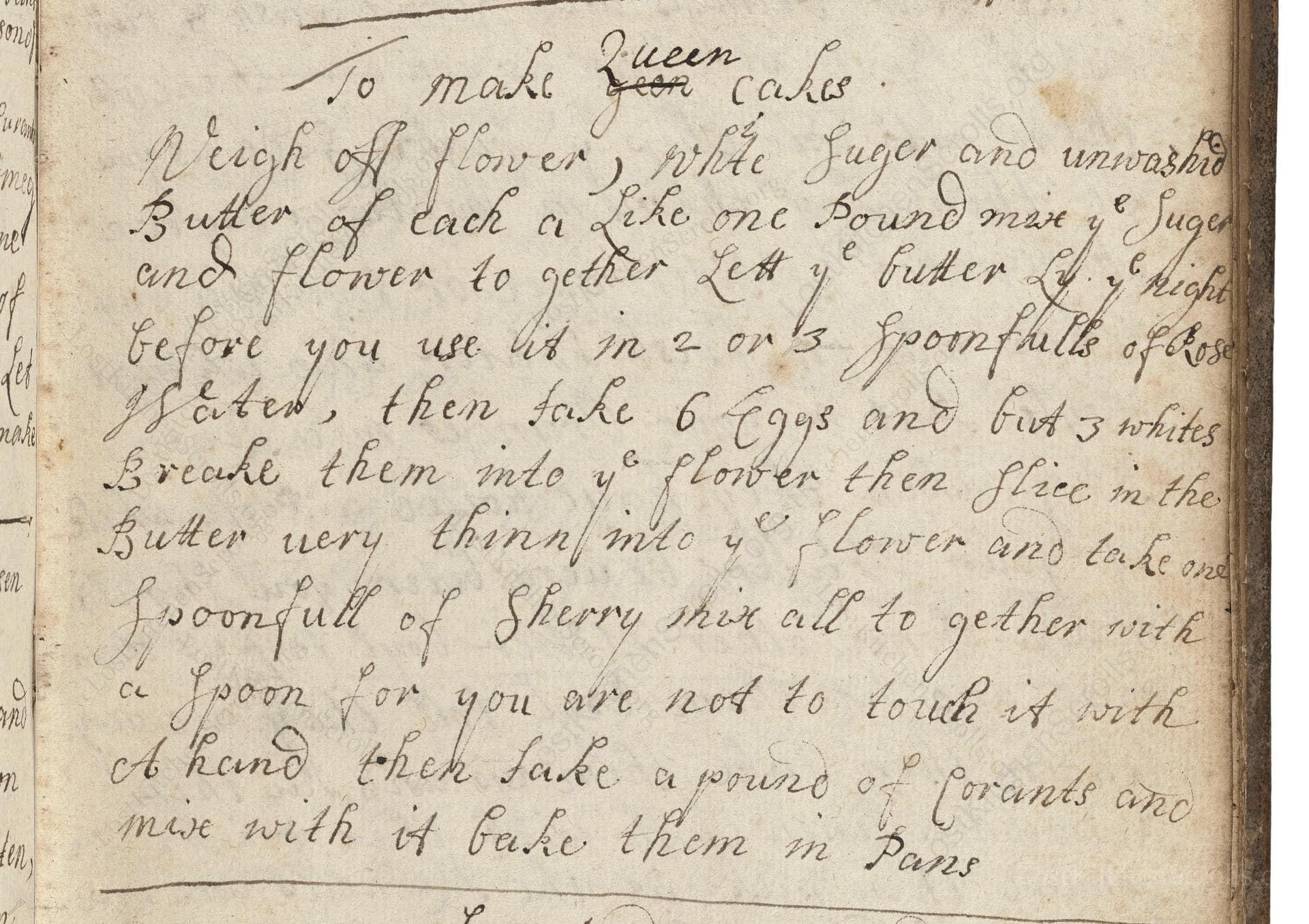To Make Queen Cakes
From the treasured pages of Medicinal, household and cookery receipts 1600s
Unknown Author

To Make Queen Cakes
"Weigh off Flower, white suger and unwashed Butter of each a like one Pound mix ye suger and flower to gether Lett ye butterr Lye a high before you use it in 2 or 3 spoonfulls of Rose water, then take 6 Eggs and but 3 whites Breake them into ye flower then slice in the Butter very thinn into ye Flower and take one spoonfull of sherry mix all to gether with a spoon for you are not to touch it with a hand then take a pound of Corants and mix with it bake them in Pans"
Note on the Original Text
The recipe is written in a typical early modern English style—hurried, with little on measures, temperature, or timing, assuming much knowledge on the part of the reader. Ingredients are given in weight (pounds) for efficiency, and spellings are often non-standard ('Flower' for 'flour', 'suger' for 'sugar', 'Corants' for 'currants', and 'ye' meaning 'the'). Instructions are a sequence of actions, not steps, and the expectation is that cooks know to test for doneness and regulate oven heat by experience. The direction not to touch the mix by hand reflects concerns about heat and texture, typical of period cake making.

Title
Medicinal, household and cookery receipts 1600s (1650)
You can also click the book image above to peruse the original tome
Writer
Unknown
Era
1650
Publisher
Unknown
Background
A delightful glimpse into the kitchens of the 17th century, this historical culinary gem serves up a feast of recipes and gastronomic secrets that will tantalize any food lover’s curiosity.
Kindly made available by
Folger Shakespeare Library
This recipe hails from English household manuscript V.a.563, dating between the 1600s and 1700s. Queen cakes enjoyed immense popularity during this time as dainty, quick bakes served at tea tables and genteel gatherings. The use of rose water and currants would have given them a uniquely fragrant floral and fruity profile—luxurious and very much in style among the upper and middle classes. The cakes took their name from their supposed association with royal courts or as a tribute to Queen Anne or Queen Victoria, and they are the ancestors of today’s classic fairy cakes and cupcakes.

Back then, a cook would have used a large wooden mixing bowl and a sturdy wooden spoon to combine the ingredients, carefully avoiding direct contact to prevent warming the butter. Cake or tart pans of small size—often pewter or tin—would have been greased with butter. The cakes were baked in a large wood-fired or coal-fired oven, with careful turning for even colour. No whisk or electric mixer in sight—the relatively brief mixing and soft butter made for a light crumb.
Prep Time
15 mins
Cook Time
25 mins
Servings
18
We've done our best to adapt this historical recipe for modern kitchens, but some details may still need refinement. We warmly welcome feedback from fellow cooks and culinary historians — your insights support the entire community!
Ingredients
- 1 lb plain white flour
- 1 lb caster sugar
- 1 lb unsalted butter (not clarified), room temperature
- 2-3 tbsp rose water
- 6 large eggs (use only 3 whites)
- 1 tbsp dry sherry or white dessert wine
- 1 lb dried currants
Instructions
- To make Queen cakes today, measure out 1 pound each of plain white flour, caster sugar, and unsalted butter (preferably not clarified or 'washed').
- Allow the butter to come to room temperature and soak it in 2-3 tablespoons (2-3 tbsp) of rose water for aromatic flavouring.
- In a large bowl, add the flour and sugar together, then crack in 6 eggs, using only 3 of the whites for richness.
- Slice the softened butter thinly and add it in.
- Pour in one tablespoon (about 1 tbsp) of dry sherry or a floral white dessert wine.
- Combine all ingredients gently with a spoon – no kneading or heavy mixing with hands.
- Finally, fold through 1 pound of currants.
- Spoon the batter into greased or paper-lined muffin tins (as a substitute for old-fashioned pans), filling each about two-thirds full.
- Bake at 350°F (180°C) for approximately 20-25 minutes, or until golden and firm.
Estimated Calories
340 per serving
Cooking Estimates
It takes about 15 minutes to measure and mix the ingredients, plus 25 minutes for baking. Each batch makes about 18 cakes, and each cake has around 340 calories.
As noted above, we have made our best effort to translate and adapt this historical recipe for modern kitchens, taking into account ingredients nowadays, cooking techniques, measurements, and so on. However, historical recipes often contain assumptions that require interpretation.
We'd love for anyone to help improve these adaptations. Community contributions are highly welcome. If you have suggestions, corrections, or cooking tips based on your experience with this recipe, please share them below.
Join the Discussion
Rate This Recipe

Den Bockfisch In Einer Fleisch Suppen Zu Kochen
This recipe hails from a German manuscript cookbook compiled in 1696, a time whe...

Die Grieß Nudlen Zumachen
This recipe comes from a rather mysterious manuscript cookbook, penned anonymous...

Ein Boudain
This recipe comes from an anonymous German-language manuscript cookbook from 169...

Ein Gesaltzen Citroni
This recipe, dating from 1696, comes from an extensive anonymous German cookbook...
Browse our complete collection of time-honored recipes



